Epsom salt is the colloquial term for magnesium sulfate (MgSO4), a crystalline salt compound that dissolves in water. This mineral salt is commonly obtained from geological formations and dried lake beds.
It can be used as a culinary salt substitute, as a supplementary source of minerals in marine aquaria, or as a magnesium and sulfate-rich resource for intensely farmed crops.
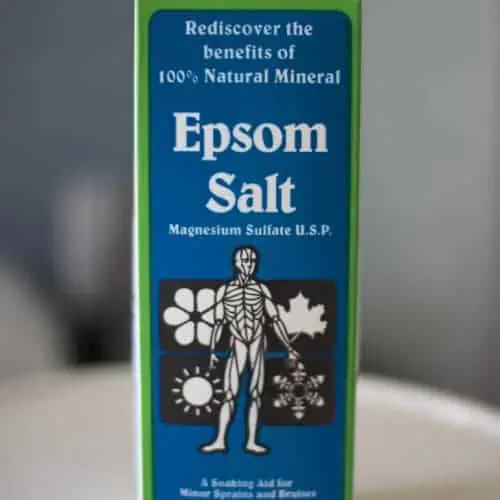
As Epsom salt is pH neutral, its application into prepared substrates does not significantly alter their alkalinity levels. The chief purpose of its application in farms is simply to counter magnesium deficiency levels.
Some gardeners believe that it aids in the control of pests, improves seed germination and flowering rates, and enhances the ability of roots to take up nutrients. Take note that these claims have yet to be scientifically supported.
Magnesium is a vital element as it forms the core of all chlorophyll molecules in plant cells. Its deficiency, though uncommon in well-draining soils, can lead to major problems like leaf discoloration and stunted growth, both of which affect photosynthesis rates.
The application of Epsom salt is especially beneficial for evergreen and flowering perennials. Using it only when a magnesium deficiency has been detected is key to improving plant development without compromising nutrient absorption rates.
1) Azaleas & rhododendrons (Rhododendron spp.)
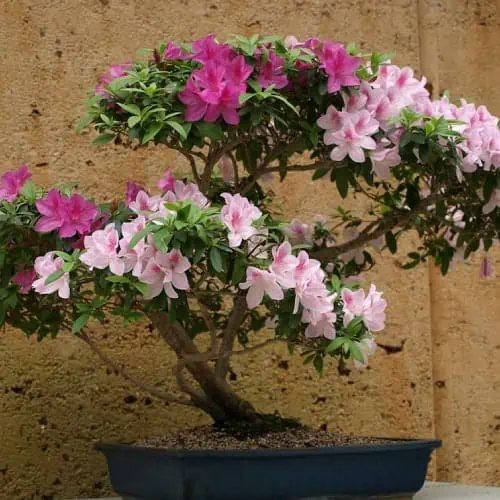
Widely cultivated as ornamental plants due to their vividly colored inflorescences, azaleas and rhododendrons are deciduous and evergreen shrubs. Some exceptional members of the Rhododendron genus can even be maintained as small trees.
Though they tend to have low nutrient requirements compared to other flowering shrubs, their best features are brought about by an occasional boost in organic materials.
In poor soils or in neutral to slightly basic substrates, azaleas and rhododendrons may fail to flower at desirable rates. Adding Epsom salt around the base of these shrubs should help promote bud production.
If the soil is especially low in trace nutrients, Epsom salt can be added as much as 1 – 2 times per month. A tablespoon of salt for every area of 10×10 feet (3×3 meters) should suffice. This can simply be worked into the upper layers of soil around the root zone.
Azaleas and rhododendrons require optimal amounts of sunlight to fully benefit from the application of Epsom salt. In full shade, most popular cultivars will fail to produce a satisfactory number of blooms despite the generous application of fertilizers.
To avoid adversely affecting your shrubs, aim to conduct a soil test for magnesium and sulfur levels beforehand.
2) Pepper plants (Capsicum spp.)
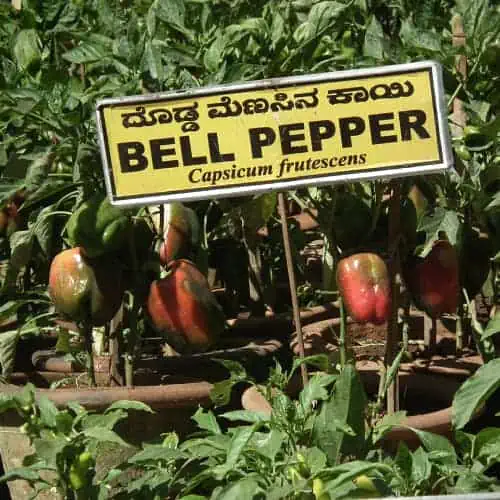
Now cultivated far outside of their native ranges to meet global demand, peppers are known for the burning sensation of their oils. These contain capsaicin, a chemical that most animals find unappealing.
Some peppers have been bred to be remarkably hot, whereas others are mild enough to be flavorful without packing a punch.
Magnesium, as a secondary or trace nutrient, is commonly deficient in farmed red bell peppers. For this reason, they can benefit from the addition of Epsom salt. Signs of magnesium deficiency include marginal chlorosis, which initially affects the older leaves.
Over time, even young leaves may lose most of their green pigmentation. Due to the loss of chlorophyll molecules, bloom and fruit production may be significantly reduced or arrested.
Epsom salt can help give pepper plants a healthy magnesium boost. It can also improve the germination rates of their seeds and the development rates of both starter and mature plants.
Simply mix a conservative amount of the salt into the germination mixture or around the base of older plants. In due time, and when provided with favorable conditions, they should begin to produce the most vibrant fruits.
3) Tomatoes (Solanum lycopersicum)
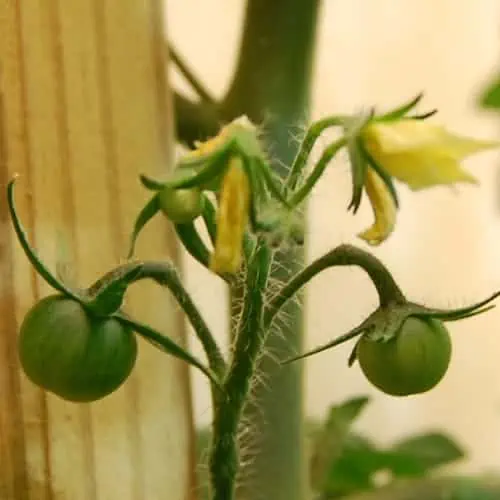
Grown for their acidic, sometimes sweet, and incredibly tasty fruits, tomatoes are some of the most valuable crops for a vegetable garden.
Today, they come in hundreds of subtly different varieties, each with its unique set of cultivation requirements. As vines, they tend to require vertical support to grow to their maximum heights. When portions of their shoots come into contact with the substrate, they may produce new roots.
Tomatoes typically require supplementary nutrients to produce desirable amounts of their flowers and fruits. Even outside the fruiting period, they can benefit from a well-balanced supply of trace nutrients.
However, these should only be applied to substrates with deficiencies. In tomatoes, magnesium deficiency is manifested by interveinal chlorosis or mottled discoloration. Over time, the deficient leaves may die back.
Epsom salt should ideally be used for tomatoes even prior to the onset of deficiency symptoms. If the substrate has been determined to be low in magnesium, you may water young tomato plants with an Epsom salt solution.
This can be done as often as once a month. Always use conservative doses of Epsom salt as an overdose can lead to calcium deficiency (usually leading to blossom end rot).
4) Roses (Rosa spp.)
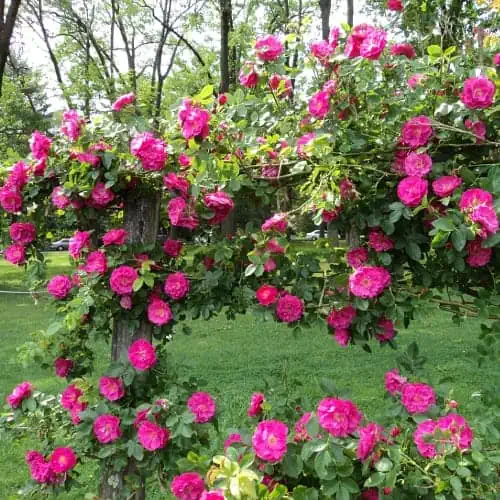
The most popular ornamental plants due to their association with love and romance, roses flourish when their roots are provided with primary nutrients (nitrogen, phosphorus, and potassium) and trace elements.
The regular provision of fertilizers boosts their root growth and flower production rates. Magnesium deficiency is quite common in stands of roses that are rooted in poorly-nourished gardens and landscapes.
The most common symptom of magnesium-poor conditions is the deterioration of older leaves. These start to die back by turning yellow along their margins. Over time, the affected leaves may become necrotic.
The use of Epsom salt is the conventional means of preventing these symptoms, though it should be applied to rose bushes just 2 – 3 times annually. The salt can be applied in its solid form or as a water-based solution around the base of the bushes. Do not use more than ¼ cup of salt per mature plant.
Note that the overfertilization of rose bushes is a common problem. If you suspect that you may have worked too much salt around the base of your plants, you can heavily water them to increase dilution rates.
Excess salt can lead to root burn, intensely dark leaves, and calcium deficiency. For this reason, you should test the soil prior to applying nutritional supplements.
5) Cucumber (Cucumis sativus)
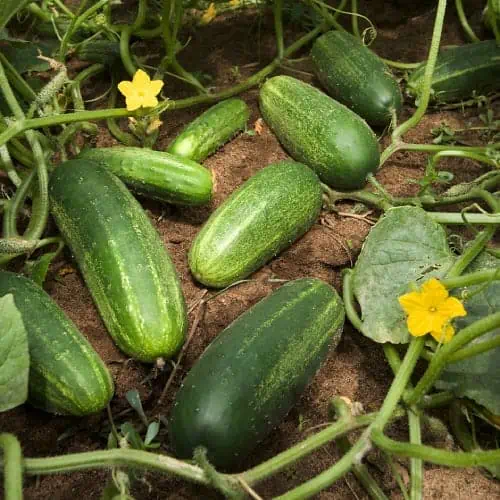
The humble cucumber, set apart by its high water content (95% of the fruit is water), is one of the oldest annuals to be cultivated as a food source. This vine spreads by creeping over rich substrates and by using its shoot’s tendrils to latch onto supporting structures.
Its cylindrical fruits, which have high concentrations of vitamin K, are actually a type of berry. The quality of its multi-lobed and pointy leaves reveals much about the health of its roots and the nutrients they can access.
If your cucumber vine’s leaves are turning yellow, they may indicate deficiencies in magnesium and iron. If you notice that the discoloration begins in the regions between major veins, it may be time to incorporate Epsom salt into the upper layers of soil.
Less than a single teaspoon of this salt (per mature plant) should be enough to balance out the substrate’s nutrient profile.
Epsom salt can maintain your cucumber plants’ spritely appearance and overall vigor. However, to avoid shocking the roots, it should only be applied once during the growth season.
To directly aid in leaf recovery, you may make use of an Epsom salt-based foliar spray. Mix a tablespoon of the salt in a gallon of fresh water, allow them to dissolve, and transfer the solution into a spray bottle for easy usage.
6) Lettuce (Lactuca sativa)
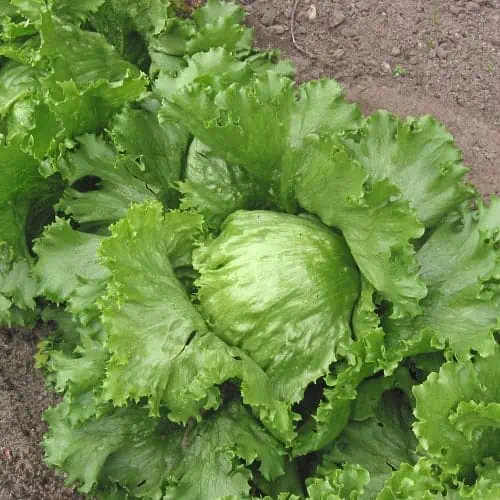
A versatile, highly nutritious, and hardy plant, lettuce is now one of the most commonly cultivated types of leafy greens. It is grown in all sorts of traditional and modern setups, including farms that make use of cutting-edge hydroponic technology.
Botanists have the nutrient requirements of the most economically valuable varieties down to a science. Deficiencies or excess concentrations of specific nutrients can quickly alter the appearance of lettuce leaves.
Low levels of magnesium affect older lettuce leaves by altering the color of their margins and interveinal zones. If left untreated, these leaves may quickly become necrotic and unsightly.
As lettuce leaves need to be evenly colored and crisp to retain their market value, magnesium deficiencies can lead to financial losses in farms. The application of an Epsom salt solution should help affected plants recover.
A teaspoon of Epsom salt dissolved in a gallon of water should suffice as an organic fertilizer for magnesium-deficient lettuce. Unless you’ve detected magnesium-deficient conditions, do not incorporate Epsom salt into substrates around lettuce roots.
Excess amounts of magnesium may affect how efficiently they take up other trace nutrients.
7) Hydrangeas (Hydrangea spp.)
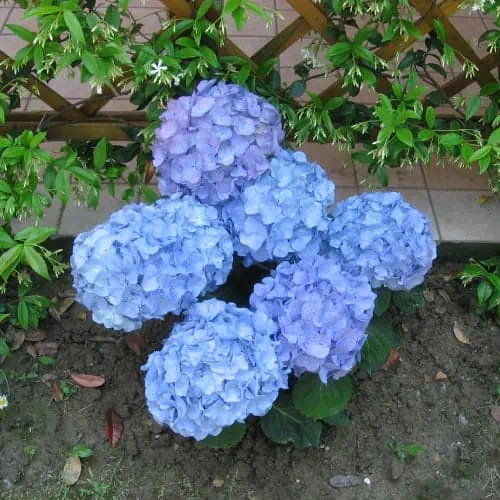
Hydrangeas tend to be heavy feeders, especially during their bloom period. They usually benefit from conservative doses of well-balanced fertilizers and organic nutrient sources, like eggshells, Epsom salt, and compost.
Deciduous or evergreen, they can quickly develop into medium-sized shrubs bearing heavy bouquets of attractive blooms. Both the quality and longevity of the inflorescences are affected by the health of these species’ leaves.
Known for having blooms that change in color depending on the alkalinity properties of the soil, hydrangeas are hyperaccumulating plants. They can grow in a wide range of pH conditions, which affects how well the roots can take up aluminum and other trace elements.
When magnesium levels are low, the leaves may increasingly turn yellow and may become necrotic. An increase in unhealthy and dropped leaves leads to reduced bloom rates.
Once you’ve determined that the soil around your hydrangea’s roots has low levels of magnesium, you can water the area with an Epsom salt solution. A single tablespoon of salt can also be worked through a surface area of about 10×10 feet.
Make sure to distribute the salts evenly as pockets with higher concentrations of magnesium can adversely affect the roots.
8) Beans (Phaseolus spp.)

Beans are nitrogen-fixing legumes that thrive in moderately fertile soils but often show sensitivity to magnesium deficiencies. Healthy bean plants produce lush foliage and abundant pods, but when magnesium levels dip, leaves may display interveinal chlorosis, reducing photosynthetic activity. S
Since beans rely heavily on leaf health to fuel pod development, a lack of magnesium can directly impact yields.
A diluted Epsom salt solution applied as a foliar spray or soil drench can restore vigor and improve pod set, especially during peak flowering and fruiting phases.
Consistent magnesium availability also helps beans resist stress from heat and irregular watering, both of which can limit harvests.
This makes them especially responsive to careful soil management, where even small adjustments in magnesium can translate into healthier vines and fuller harvest baskets.
9) Carrots (Daucus carota subsp. sativus)

As a root crop, carrots demand balanced nutrients to support both foliage and underground storage development. Magnesium deficiencies often manifest as pale, weak tops that limit the plant’s ability to channel energy into root growth.
Epsom salt, when used sparingly, can strengthen leaf color and improve sugar transport, resulting in sweeter, better-formed roots.
Gardeners often find that supplementing magnesium during the mid-growth stage promotes uniform carrot size and reduces the risk of woody textures.
In sandy or highly cultivated soils, where nutrients leach quickly, magnesium supplementation can make a noticeable difference in root quality.
Even a modest boost of magnesium can improve both yield and flavor, leading to crisper, more vibrant carrots that store better and taste sweeter on the table.
10) Broccoli (Brassica oleracea var. italica)

Broccoli is a cool-season brassica that requires consistent nutrition to form dense, flavorful heads. Magnesium is critical for chlorophyll production, and without it, plants may suffer from stunted growth and faded foliage.
Because broccoli is a relatively heavy feeder, Epsom salt can be a valuable supplement to bolster leaf strength and maintain steady growth.
Applied during the vegetative stage, magnesium sulfate helps ensure that the plant has enough energy reserves to support compact, fully developed florets.
When magnesium levels are balanced, broccoli also tends to produce more uniform side shoots after the main head is harvested. This leads to a longer and more productive harvest season.
This leads to a longer and more productive harvest season, giving gardeners the chance to enjoy multiple flushes of tender, nutrient-rich florets over time.
11) Spinach (Spinacia oleracea)

Spinach is a leafy green that matures quickly but is prone to nutrient imbalances in depleted soils. Magnesium deficiency can cause leaves to yellow prematurely, reducing both yield and nutritional value.
Since spinach is harvested for its foliage, maintaining deep green, healthy leaves is essential.
A light application of Epsom salt, either through irrigation water or as a foliar spray, can correct deficiencies and sustain vigorous leaf production throughout successive harvests.
This added magnesium also enhances the plant’s resilience against bolting in warmer conditions, extending the harvest window.
As a result, spinach beds stay lush and productive for longer, offering gardeners a steady supply of tender leaves that can be picked fresh for salads, sautés, and smoothies.
12) Apple Trees (Malus domestica)

Fruit trees like apples often require supplemental nutrients to maintain consistent productivity over many seasons. Magnesium shortages can lead to poor leaf health, premature fruit drop, and reduced sugar accumulation in apples.
Because magnesium plays a role in photosynthesis and carbohydrate transport, Epsom salt can be particularly helpful in orchards with sandy or acidic soils.
A soil drench around the root zone in spring or early summer can enhance leaf vitality and contribute to larger, sweeter fruit.
Repeated yearly applications in moderation can also help trees maintain long-term vigor and steady cropping cycles.
This simple addition can make a visible difference in both tree health and fruit quality, ensuring that apple harvests remain abundant, flavorful, and reliable year after year.
13) Grapevines (Vitis vinifera)

Grapevines are perennial plants that demand balanced nutrition to support both vegetative growth and fruit set. Magnesium deficiency is a common issue in vineyards, often showing as yellowing between the veins of older leaves.
This imbalance reduces photosynthetic efficiency, which in turn affects grape quality and sugar content.
Applying Epsom salt during the growing season can help restore magnesium levels, improve berry development, and enhance the overall flavor profile of the harvest.
In addition, healthier foliage allows vines to ripen fruit more evenly, which is especially important for winemaking varieties.
Well-fed vines also show stronger resistance to environmental stress, allowing them to produce consistent yields of rich, flavorful grapes across many growing seasons.
14) Strawberries (Fragaria × ananassa)

Strawberries are shallow-rooted plants that can quickly deplete nutrients in their immediate soil environment. Magnesium deficiency often results in weak foliage and smaller, less flavorful berries.
Since strawberries rely heavily on healthy leaves to fuel fruiting, restoring magnesium levels with Epsom salt can improve both yield and taste.
A light application during early flowering and again during fruit development helps maintain robust growth and supports the production of plump, juicy berries.
Gardeners often notice that magnesium-fed plants also produce stronger runners, which can expand the patch more successfully.
This ensures a healthier and more productive strawberry bed year after year, rewarding growers with bigger harvests and a longer fruiting season.
15) Potatoes (Solanum tuberosum)

Potatoes are tuber crops that require steady nutrition to form plump, well-developed harvests. Magnesium deficiency in potato plants often appears as yellowing between the veins of older leaves, which can reduce photosynthesis and limit tuber size.
Epsom salt applications can help restore leaf color, improve nutrient transport, and support starch accumulation in developing tubers.
Gardeners often apply magnesium sulfate during the early growth stages to encourage strong foliage and again during tuber bulking for maximum yield.
Consistent magnesium levels not only improve the size and flavor of potatoes but also help reduce the risk of hollow or misshapen tubers.
16) Lemon Trees (Citrus limon)

Lemon trees are evergreen fruiting plants that rely heavily on nutrient balance to maintain healthy foliage and steady fruiting. Magnesium deficiency often shows as yellowing leaves with green veins, a condition that can weaken the tree and reduce fruit quality.
Applying Epsom salt as a foliar spray or soil drench can quickly correct this imbalance, restoring vibrant green leaves and improving the tree’s overall vigor.
When magnesium levels are stable, lemon trees tend to produce juicier, more flavorful fruit with fewer drops during development.
This simple supplement can make a noticeable difference in both the health of the tree and the abundance of its citrus harvest.
17) Blueberries (Vaccinium corymbosum)

Blueberries are acid-loving shrubs that require specific soil conditions to thrive, particularly when it comes to nutrient uptake.
Magnesium deficiency often reveals itself as reddening leaves or poor fruit set, which can limit both yield and berry sweetness.
Epsom salt, applied sparingly around the root zone or as a foliar spray, can restore balance and encourage lush foliage.
Gardeners often notice that magnesium supplementation also enhances berry size and improves the plant’s ability to withstand seasonal stress.
With steady magnesium support, blueberry bushes reward growers with bigger harvests of plump, flavorful berries year after year.
18) Zucchini (Cucurbita pepo)

Zucchini is a fast-growing summer squash that produces heavily when given proper nutrition. Magnesium is essential for strong leaf growth and flower production, and deficiencies can quickly lead to pale foliage and reduced fruit set.
Adding Epsom salt during the early growth stages helps maintain vigorous vines and supports the heavy energy demands of continuous fruiting.
Healthy magnesium levels also encourage better pollination and more uniform fruit development.
As a result, zucchini plants stay productive for longer, yielding tender, flavorful squash throughout the growing season.
Plants That Don’t Like Epsom Salt
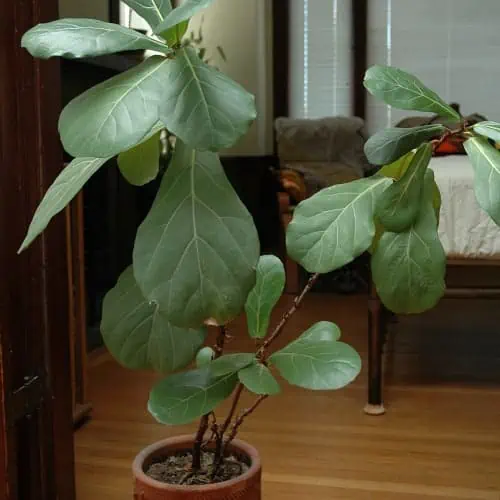
There continues to be much contention about the use of Epsom salts, especially as not all plants respond to supplemented magnesium and sulfur in the same way.
Some sensitive species can quickly become damaged due to exposure to salts, even in acidic and magnesium-poor substrates. For some plants, a well-balanced fertilizer or a store-bought, mineral-rich potting mix should suffice to provide them with all the magnesium and sulfur they need.
It must be noted that, in many cases, the unnecessary usage of Epsom salts (in soils that do not have an existing magnesium deficiency) leads to unfavorable symptoms.
Some horticulturists avoid using salts as they prefer fertilizers or organic mixtures, like compost, that are not composed of just a single nutrient or mineral. Consider using manure, a slow-release fertilizer, or enriched compost for the magnesium-sensitive plants below:
- Common tropical houseplants like monsteras, fiddle leaf figs, palms, and philodendrons
- Carnivorous plants
- Conifer trees
- Ornamental plants in soils that have normal levels of magnesium
Magnesium toxicity occurs when substrates that are already high in nutrients, including magnesium, are supplemented with compounds like Epsom salt. This can be dangerous to plants because their capacity to absorb other nutrients becomes affected.
In cases where symptoms like chlorosis are observed, even if magnesium levels are adequate, do not use Epsom salt. Instead, you can manage the availability of nutrients by controlling pH levels.

